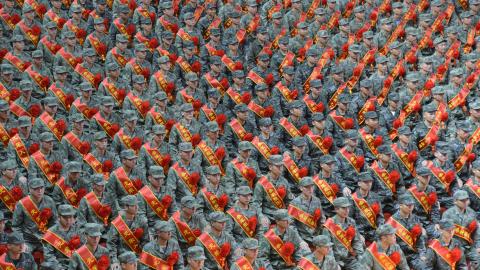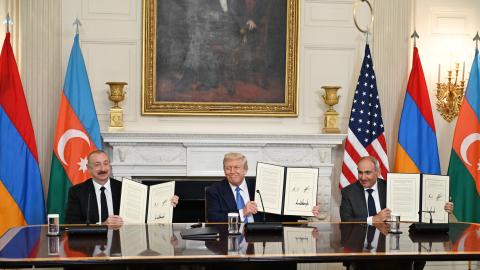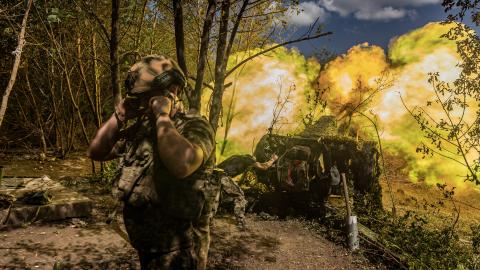Russia’s invasion of Ukraine last year fundamentally changed the geopolitical landscape of Europe in ways not seen in almost 80 years.
Europeans are now spending more on defense than they have in recent memory. Neutral and militarily non-aligned countries are joining NATO. After decades of dependency, Europe has shifted its energy reliance away from Russia in a manner previously thought impossible.
Unsurprisingly, one of the greatest geopolitical changes in Europe is with Ukraine. Since the revolution in 2014, there has been no doubt that Ukraine’s destiny is inside the European family and outside Moscow’s orbit. Even so, progress for Ukraine’s membership of institutions such as NATO and the EU has moved at a snail’s pace.
Over the past 18 months this has changed. Paradoxically, thanks to Russia’s invasion last year which was meant to keep Kyiv away from Europe, Ukraine has never been closer to joining its institutions. Ukraine is now an official candidate country to join the EU and has started to make the necessary legal, government, and economic reforms required to join. Although Ukraine didn’t receive an invitation to join NATO during the recent summit, the alliance made it very clear that Ukraine will some day be a member.
While the issue of Ukrainian EU and NATO membership features prominently in headlines and the debate about the future of Europe, there are two other important steps being taken to bring Ukraine closer to the Euro-Atlantic community in a way that would have been impossible to imagine just a few years ago.
First is the commitment to provide Ukraine with F-16 fighter jets. Yes, Ukraine has received a lot of Western equipment and training in recent years, but the F-16 takes the relationship to a new level. The UK was the first country to say it would train Ukrainians on the F-16 before the summer. Last week the White House finally gave the green light and Denmark and the Netherlands promised to donate up to 61 F-16s to Ukraine. Norway will also supply the jets to Ukraine.
The importance of Ukraine receiving F-16s goes beyond the tactical advantages they bring to the battlefield. There is also an important strategic element. Supplying Ukraine with such a sophisticated aircraftdemonstrates a long-term commitment by the West to Ukraine’s security. Its arrival will mark a fundamental shift away from Ukraine’s reliance on Soviet-era and Russian designed fighter jets. Due to the length of training that is required operate the F-16, and the scale of the financial investment needed to help Ukraine do so, the entry of the F-16 into Ukraine’s arsenal anchors the country to the West in a way not otherwise possible.
Second, plans by European defense companies to start producing munitions and equipment in Ukraine also demonstrate a long-term commitment to Ukraine’s security. Again, this is something that would have been unthinkable before 2022. Eight months after Sweden provided 50 of its CV90 armored vehicles to Ukraine, the two reached an agreement last week to “strengthen cooperation in production, operation, training and servicing of the CV90.” President Volodymyr Zelensky said this would lead to the production of CV90 in Ukraine.
German defense company Rheinmetall started negotiations with Kyiv this year for the establishment of a factory in Ukraine that could produce up to 400 tanks a year. Already, the Turkish drone-maker Baykar’s first turbofan-powered unmanned aircraft, Kizilelma, is outfitted with Ukrainian produced engines. This summer, construction of a new Baykar factory began in Ukraine. Once finished it will produce world-class Bayraktar TB2 drones. Ukraine is also working with European countries to manufacture NATO standard 155mm and 120mm artillery rounds, different from the Soviet-era Russian standard 152mm and 122mm caliber.
The production of European armaments inside Ukraine will not only help it on the battlefield now, but will also make Kyiv well placed to be a defense exporter in the future. A robust Ukrainian defense industry could have positive implications for regions outside Europe, including the Middle East.
Ukraine already has a track record of defense exports. Before Russia’s annexation of Crimea in 2014, itroutinely ranked among the world’s top five defense exporting countries. In recent years Saudi Arabia was Ukraine’s second-largest export market and Qatar was the seventh. In a postwar scenario, it is likely that Ukraine will become one of the world’s top weapons exporters again.
In the past 18 months, rapid breakthroughs in “combat tested” defense innovation are likely to make Ukraine’s domestically manufactured weapons highly sought after around the world. This is especially true when it comes to technological breakthroughs in unmanned seaborne drones, which have been successful targeting the Kerch bridge and Russian warships in the Black Sea. Ukraine’s domestically produced anti-ship missile, responsible for the sinking of the Moskva last year, will be appealing for countries wanting to increase their coastal defense at a relatively low cost. This is particularly true with some Gulf states.
Also, many countries that already purchase Russian manufactured military hardware are quickly learning how ineffective it is on the 21st century battlefield. These countries are likely to be reassessing their reliance on Russian hardware and will develop a plan to diversify away from it. In this context, there is no doubt that Ukrainian defense goods will become an increasingly attractive alternative.
As Ukraine integrates into Euro-Atlantic community, defense cooperation with the US and European countries will help it along the way. But the impact of this defense cooperation will be felt beyond Europe. The Middle East is no exception.


















